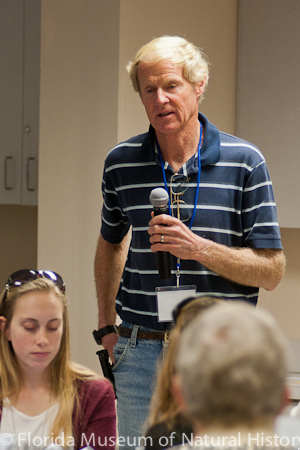Reflections from the North American Paleontological Convention
by Lee Cone, Friends of the Aurora Fossil Museum

Last year the Friends of the AFM was contacted by the Florida Museum of Natural History about taking part in a national program called The FOSSIL Project. Carol presented the introductory letter to the Friends Board, and the board agreed to look into the program. As Friends President, I revisited this idea in October, and after talking to the project coordinator I felt as though it truly was a worthwhile venture to attend. This developmental program was hosted by the University of Florida and held in conjunction with the North American Paleontological Convention (NAPC), a once in four year international event, which drew presenters from 28 countries and featured in excess of 350 individual presentations over the week-long event. Getting there turned out to be quite a timing problem, since the southeast was hit by snow and ice the day before my plane departed. With the flight cancelled, improvised new plans called for an 8 hour “road trip”, and fortunately I-95 was traffic free and road conditions were no problem. I cannot say enough about the organization of the University of Florida’s paleontology staff at every level. The hotel arrangements, field trips, banquets, time schedule for presenters, and work sessions were carried out with amazing fluidity, punctuality, and attention to detail.
At our introductory meeting, we were informed that there were 60 organized amateur groups in the U.S., and that half were represented at the symposium spanning America from Aurora, NC to the state of Washington. As amateur paleontologists, all of the representatives of the fossil clubs, support groups, and museum societies felt honored to be able to be a part of the professional side of research presentations. We had the opportunity to format our own schedule of presentations, where professional paleontologists discussed their research abstracts in conference rooms filled with both amateur and professional paleontologists. Saturday, Sunday, and Monday were simultaneously intimidating, intellectually stimulating, reflecting, and educationally exciting. For those three days I felt as though I was back in graduate school feasting on cutting edge research and knowledge from every conceivable point of the paleontology spectrum. It was eye opening for me as an amateur collector. I had no idea how much information could be gained, beyond the bones themselves, about paleo-: ecosystems, climate, evolution, species interactions, and isotope technology.
I also became acutely aware of the importance of the entire fossil site, which, understandably, may actually be more important than the specimens themselves to the professional. Herein lies one of the ravines which separate the professionals from the amateurs. It was revealed at the convention that 70-80% of all specimens in museums were collected by amateurs, thereby linking the importance of the amateur to the professional paleontologist. By counterpoint, though, I also realize how much knowledge can conceivably be kept from the paleontologist, because a complete investigation of a site was not made available to the professional. The FOSSIL Project serves as a starting point toward linking amateurs and professionals in a working network that will generate better research data for the future.
The other comment that really surprised me, made by the professionals, was that they envied the amateurs for their opportunity to be out in the field. Over and over many stated that they rarely had the chance to get out in the field, and that their lives were spent analyzing the collected data by others. Since symposium talks were given in 5 separate rooms throughout the day, I was only able to hear 20% of the total volume of presentations, but even at that small percentage, I really became aware of the importance of the small details to the professionals. These details are commonly overlooked and unnoticed by amateur collectors, as their thoughts are focused totally on the specimen.
By networking through The FOSSIL Project it may be possible in the future to collect and share valuable data with professionals for their research. By expanding the dissemination of information both digitally and electronically, researchers are not limited to regional information filtering into museums and universities, but rather would have access to a much broader scope of information. By networking the various clubs, societies, and support groups, there will exist a connection that could be beneficial in areas of public outreach, club linked activities, digital sharing of collections and identification, fossil fairs, and engaging the knowledge that support of each other ultimately unites and strengthens the entire FOSSIL Project network from amateurs through the professional paleontologist.
It is important that the Friends of the Aurora Fossil Museum remain an integral part of this endeavor and further support The FOSSIL Project. Clearly the role of every amateur fossil organization varies throughout the country, but the architects of The FOSSIL Project hold a view that each organization will see benefits from the whole, and that FOSSIL will be driven by the needs of those that are involved. We all share a passion for fossils, and that passion is the same whether you are an amateur or a professional, or whether you are from Aurora, NC or the state of Washington.